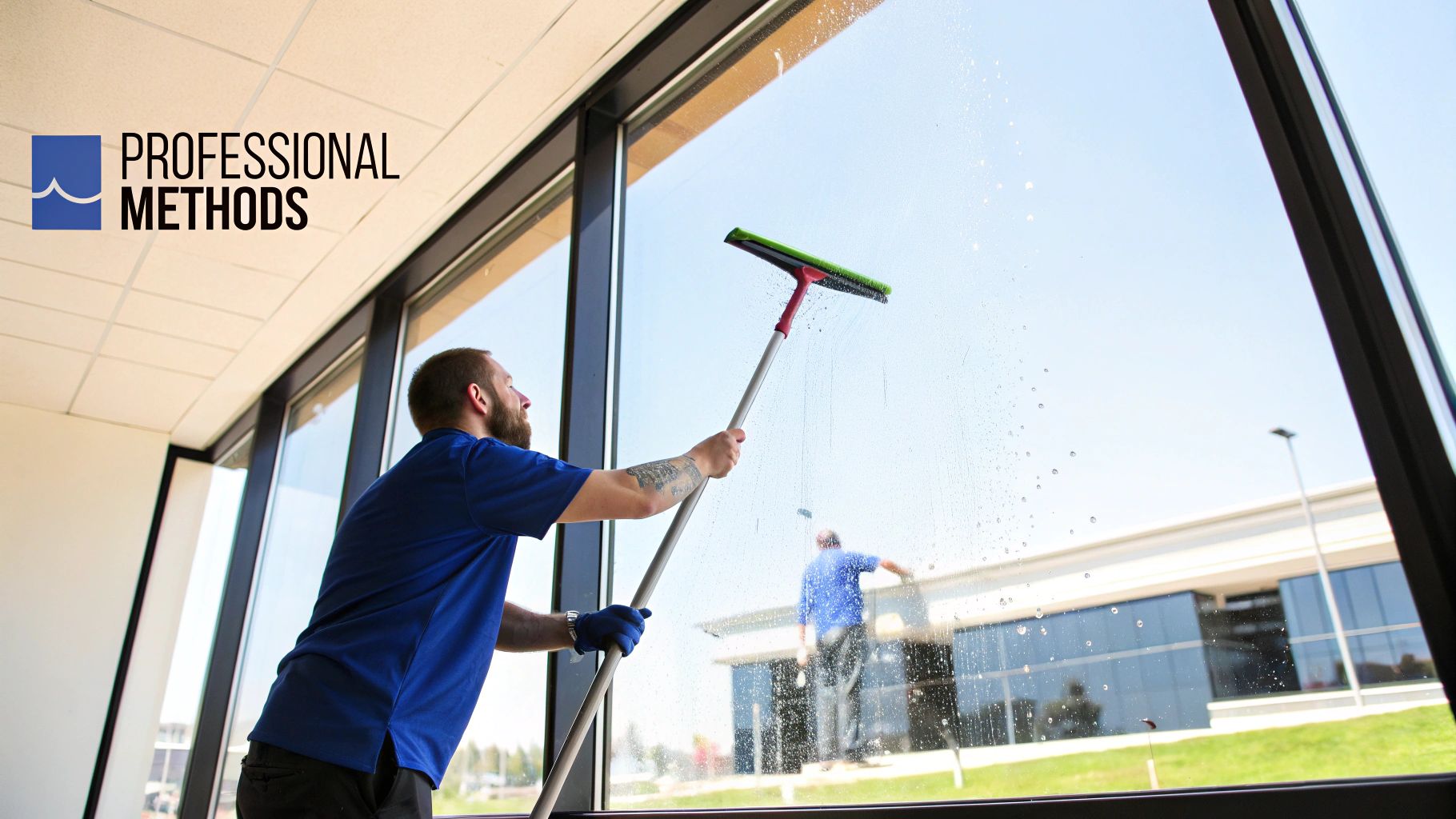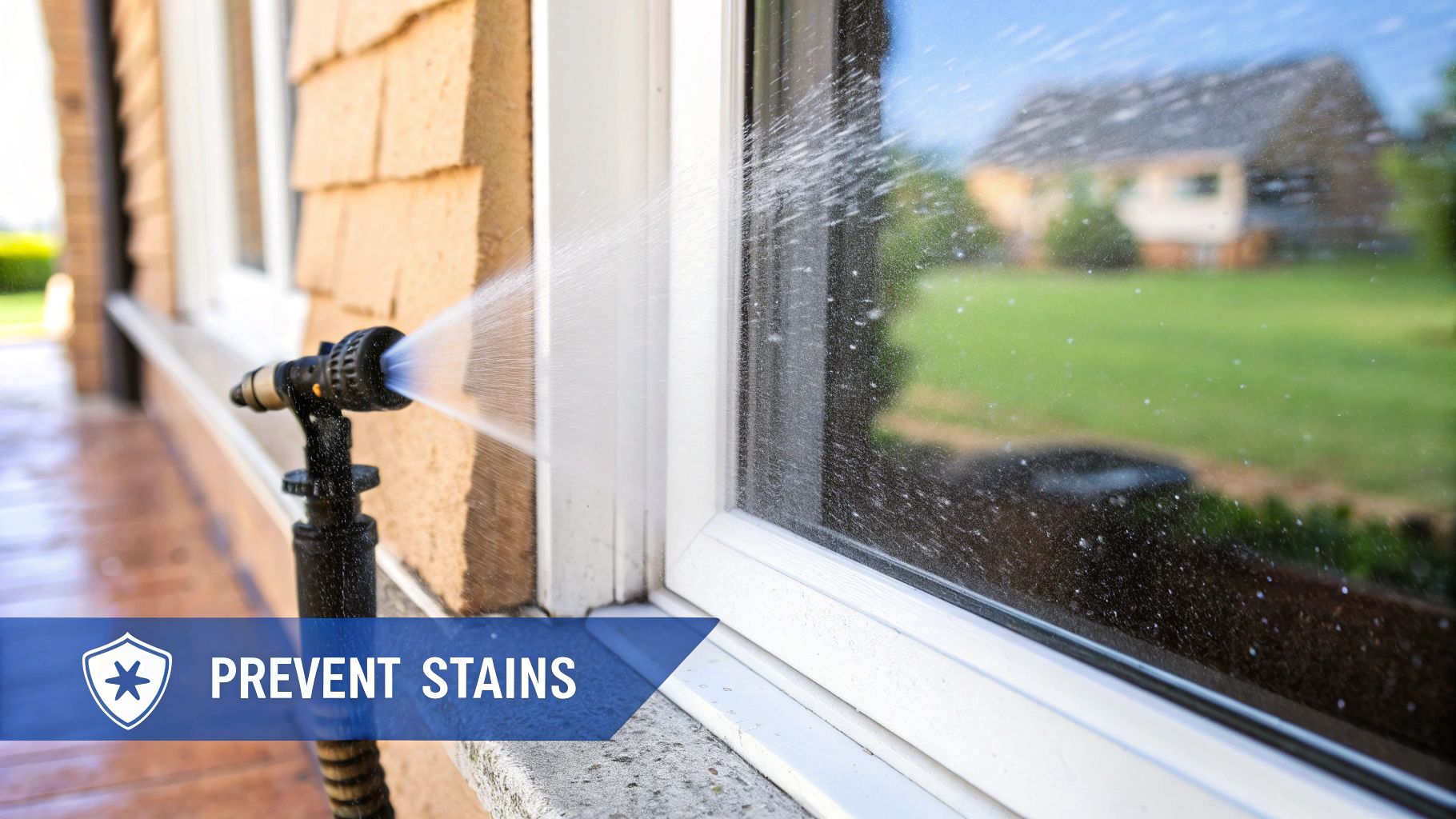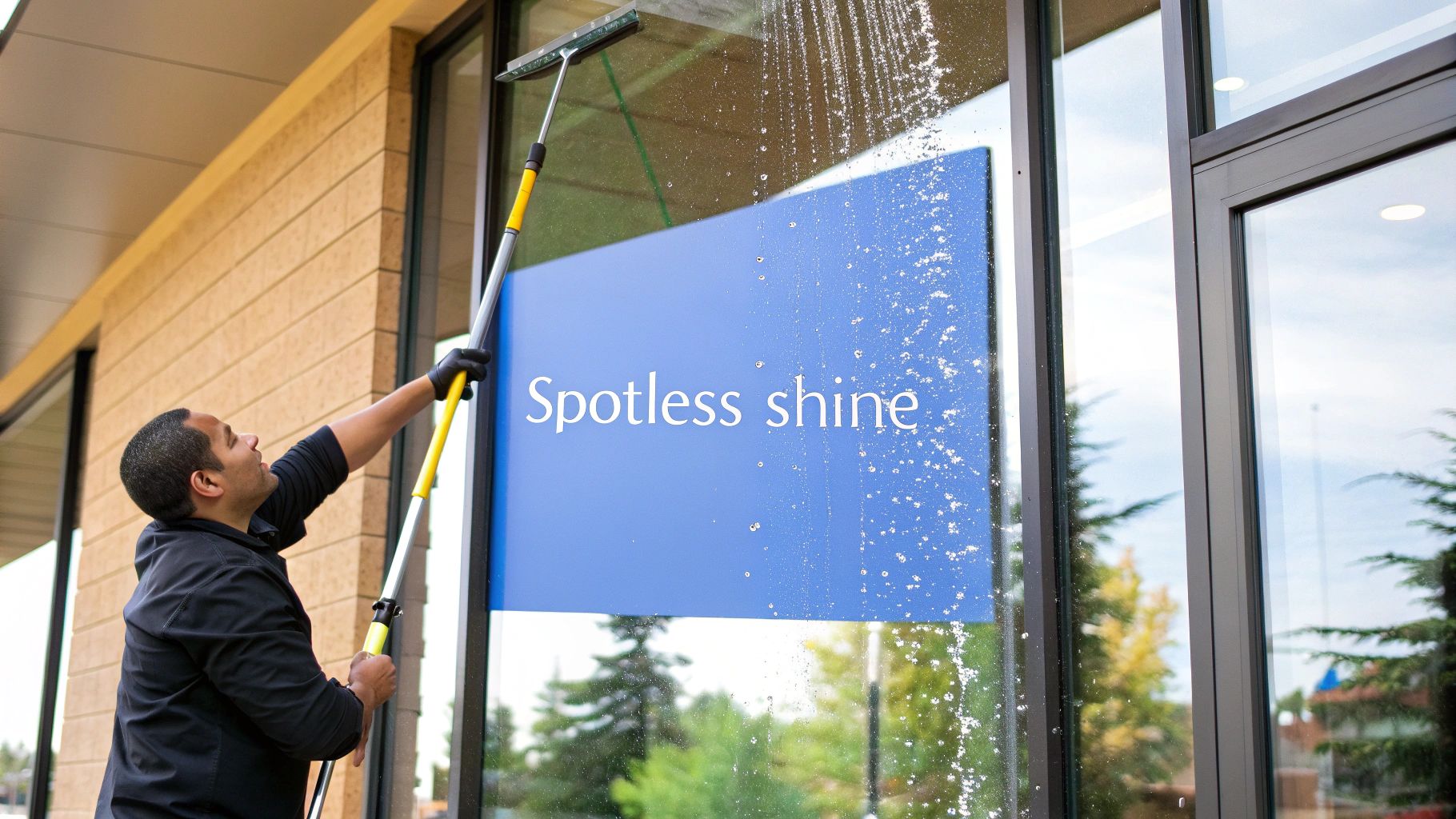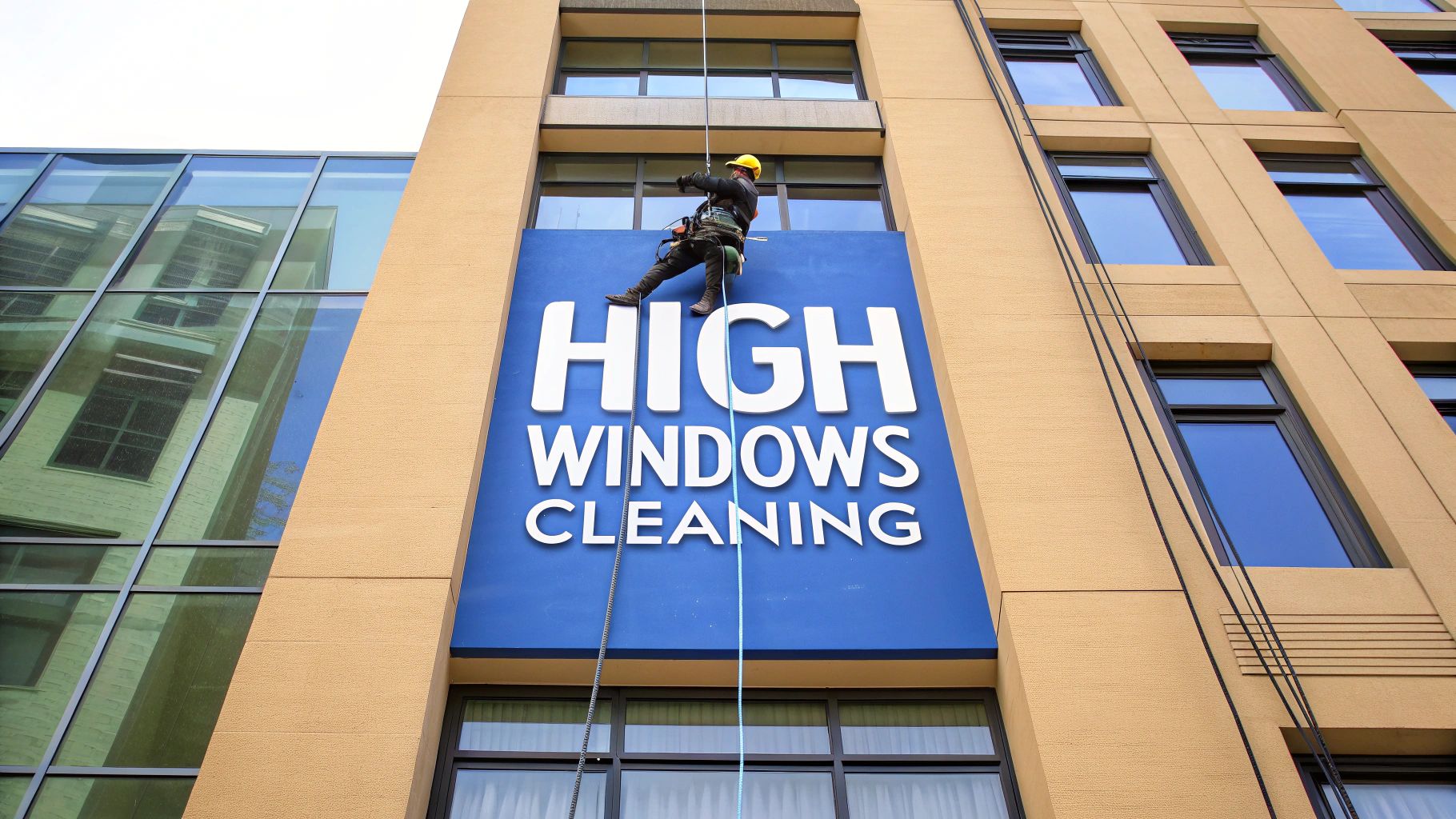removing water stains from windows: fast, easy home remedies

It’s a headache every property owner knows well: you clean your windows, only for them to dry with those same cloudy, stubborn spots still clinging to the glass. This isn't just about fighting off dirt; it's a battle against a chemical bond.
Those annoying stains are hard mineral deposits, mostly calcium and magnesium, that have literally etched themselves into the porous surface of your windows. To get a truly professional, streak-free shine, you need to dissolve those deposits—and for that, the right acidic solution or mild abrasive paired with a squeegee or a pure-water system is your best bet.
Why Water Stains Won't Just Wipe Away
So, why are these spots so persistent? It all comes down to chemistry.
When a drop of water evaporates, it leaves its mineral content behind. Over time, these tiny deposits build up and chemically bond with the glass. You’re no longer just cleaning something on the window; you’re trying to reverse a chemical reaction that has become part of the surface itself. Standard soap and water just can't break that bond.
The Real Culprits Behind Stubborn Window Stains
Understanding where these minerals come from is the key to preventing future stains. The sources are often right in our own backyards.
- Sprinkler Systems: In places with hard water, like Phoenix, sprinkler overspray is enemy number one. Every droplet that lands on your window leaves a tiny but concentrated mineral deposit behind as it dries.
- Rainwater: Believe it or not, rain isn't pure H2O. As it falls, it picks up airborne pollutants and minerals. In busy urban centers like Denver, this can lead to a gradual buildup of stains over time.
- Runoff: Water running down from concrete, stucco, or metal window frames is another major source. It can carry minerals and leachates that drip down and stain the glass below.
This problem is so widespread that it has created a massive service industry. The global window cleaning market, which deals heavily with removing water stains from windows, was valued at USD 4.18 billion and is only expected to grow. You can read more about the window cleaning services market to see just how significant it is.
The most important thing to remember is that you're dealing with a buildup that has become one with the glass. This is why scrubbing too hard with the wrong tool will scratch your windows, while weak cleaners won't do a thing. Professionals in cities like Las Vegas use specific techniques—like a squeegee method or pure-water systems—precisely because they tackle the problem at a chemical level without causing damage.
How to Diagnose Your Window Water Stains
Not all water stains are created equal, and this is a lesson many homeowners learn the hard way. Before you grab a bottle of cleaner and start scrubbing, you need to know exactly what you’re up against. Using the wrong approach can waste hours of your time or, even worse, permanently damage your glass.
The good news is that figuring out how bad the stain is takes just a few seconds. The key is to determine whether you're dealing with fresh mineral deposits sitting on top of the glass or advanced corrosion that has actually etched into the surface. These two stages require completely different game plans.
The Fingernail Test
Here’s a quick trick I use on almost every job. Gently run your fingernail across one of the water spots. What you feel will tell you everything you need to know.
- You feel a raised, slightly rough deposit: This is what we call a Stage 1 stain. It means the minerals are still just sitting on the surface and haven't caused permanent damage yet. Think of recent sprinkler overspray that leaves a light, powdery residue. These stains can almost always be removed with a good, deep cleaning.
- The surface feels smooth or even slightly pitted: This is a Stage 2 stain, and it’s a whole different animal. The minerals have been on the glass for so long that they've started to corrode it, leaving behind a milky haze or semi-permanent cloudiness. You're no longer feeling the deposit; you're feeling the etched glass itself. At this point, you’re looking at a restoration project, not a simple cleaning.
To help you figure out what you're dealing with, I've put together a quick reference table. It breaks down the stain types and what you should do next.
Water Stain Severity and Recommended Actions
This table is your starting point for tackling any water stain. Correctly identifying the severity ensures you use the right tools for the job and avoid making the problem worse.
This simple diagnostic test helps you decide if you just need basic cleaning gear or if it’s time to call in a pro for a more intensive restoration process. To help you visualize the most common causes, this decision tree shows how sprinklers and rain can both lead to frustrating stains.

As the infographic shows, whether it’s your own sprinkler system or just a season of hard rain, both can leave behind mineral deposits that need to be dealt with correctly.
Why Correct Diagnosis Matters
Knowing the difference between Stage 1 and Stage 2 is absolutely critical because it dictates your entire plan of attack. For a Stage 1 stain, a professional would likely use a high-quality squeegee and a specialized solution to lift the surface deposits without harming the glass.
But for a Stage 2 stain, a more abrasive approach is often needed, which is best left to trained technicians to avoid creating a bigger mess.
Attempting to scrub away a Stage 2 stain with the wrong tools is one of the most common ways homeowners accidentally scratch their windows. The minerals become embedded, and aggressive scrubbing just grinds them into the glass, causing permanent damage.
By taking a moment to diagnose your stains, you can choose the right method from the start. It'll save you time, frustration, and the potential cost of replacing a window. This initial assessment is easily the most important step in successfully removing water stains from windows for good.
The Two Pro-Level Window Cleaning Methods That Actually Work

If you've spent any time Googling how to get rid of water stains, you've probably seen every DIY hack in the book. Vinegar, baking soda, even toothpaste. While these might make a small dent in fresh, light spots, they just don't stand a chance against stubborn, built-up mineral deposits.
When it comes to getting that flawless, streak-free shine every single time, professionals stick to two tried-and-true methods: the classic squeegee technique and the high-tech pure-water system.
These aren't just random choices. They're systematic approaches designed to eliminate the root cause of water stains without harming your glass. And the demand for this expertise is huge—the combined window cleaning workforce in Canada and the US is over 12,244 professionals strong, as detailed in this market analysis report.
The Classic Squeegee Technique
In the hands of a pro, a squeegee is a precision instrument, not just a rubber blade on a stick. This method is the undisputed champion for ground-level windows and indoor glass, delivering perfect results when executed correctly. It’s all about a combination of three key elements.
- The Right Solution: We don't just use soap and water. Professionals use specially formulated "slip" solutions that lubricate the glass. This allows the squeegee to glide effortlessly while lifting dirt and minerals completely off the surface.
- A High-Quality Tool: A cheap, stiff squeegee from a big-box store will skip, chatter, and leave ugly streaks. Pros invest in tools with soft, pliable rubber blades that create a perfect, watertight seal against the glass.
- Proper Technique: That iconic "S-curve" or "fanning" motion isn't just for show. It’s a proven technique to control water flow, pulling it away from the cleaned area so no dirty water is left behind to dry and create new spots.
This method is fantastic for exterior windows, but mastering it inside without making a mess is a whole other skill. For tips on that, check out our guide on the best way to clean inside windows.
Here's a common mistake I see homeowners make: they press way too hard. A professional lets the sharp edge of the rubber do the work, applying just enough pressure to stay flat against the glass. That light touch is the secret to a streak-free finish.
The Power of Pure Water Systems
For high windows or really severe hard water buildup, we bring out the heavy artillery: pure-water systems. This technology has been a game-changer, especially for multi-story homes common in places like Denver, where safely reaching a third-story window is a serious challenge.
So, how does it work? The system filters regular tap water through a multi-stage process, usually involving reverse osmosis and deionization. This strips out 100% of the dissolved solids—calcium, magnesium, you name it—leaving the water in an aggressive, "pure" state.
When this deionized water is fed through a long, lightweight pole and sprayed on the window, it acts like a magnet. It literally pulls the mineral deposits and dirt off the glass, dissolving them into the water stream. A gentle scrub with a soft-bristled brush attached to the pole helps loosen any stubborn grime.
But the real magic happens at the end. Because the water is completely pure, you can just rinse the window and let it air-dry. No squeegee needed. It dries perfectly clear without leaving a single spot or streak behind. This makes it an incredibly efficient way for removing water stains from windows that are high up or hard to get to. The result isn't just clean; it's an exceptional level of clarity.
Tackling Stubborn Etched-In Mineral Deposits
So, you've scrubbed and squeegeed, but the stains remain. Sometimes, hard water spots are so severe they seem to have become part of the glass itself.
If you run your hand over the stain and feel nothing—just smooth or slightly pitted glass—you’re likely dealing with Stage 2 corrosion. This is where standard cleaning stops and professional restoration begins.
These etched-in deposits are beyond a simple spray and wipe. To fix this, pros turn to specialized techniques that gently polish away years of mineral buildup without scratching the glass. It’s not about brute force; it’s about using the right tools with a practiced, precise touch.
The Professional Polishing Approach
For these advanced cases, we have to physically remove the minerals that have bonded to the glass. In my experience, two of the most effective and safest options are ultra-fine steel wool and specialized abrasive compounds.
- #0000 Grade Steel Wool: This isn't the coarse stuff you find under the kitchen sink. #0000 (quadruple-ought) grade is incredibly fine. When used correctly, it can polish glass without leaving a single scratch.
- Glass-Safe Abrasive Compounds: These are professional-grade polishing pastes or powders designed specifically for glass restoration. They contain microscopic abrasives that gently buff out the mineral etching, almost like an exfoliant for your windows.
The key to this entire process is lubrication. A pro never uses these tools on dry glass—that’s a recipe for disaster. We use a constant flow of cleaning solution or water to create a slick, slippery surface. This lets the polishing tool glide smoothly and helps carry away the loosened mineral debris. It's a critical step in removing water stains from windows without causing new damage.
The most important rule of glass restoration is to always test a small, hidden spot first. This quick check ensures the technique is working and won't harm that specific type of glass, which is especially important for tinted or coated windows.
When a Mild Acidic Cleaner is Necessary
For extremely heavy calcium and magnesium deposits, sometimes you have to bring in a little chemistry. A mild, professional-grade acidic cleaner can be a lifesaver. These solutions are formulated to dissolve the stubborn alkaline mineral buildup, chemically breaking its bond with the glass.
This is a targeted approach used sparingly and with great care. If you're not careful, these solutions can damage window frames or surrounding surfaces.
The building window cleaning systems market, which includes the advanced tools and solutions needed for this kind of work, was valued at USD 1.5 billion in 2022 and is projected to keep growing. The principles of using targeted solutions to break down mineral bonds apply to other surfaces, too, like removing rust stains from toilets.
This level of restoration is how professionals salvage glass that many people might assume is ruined forever. For more guidance on tackling hard water, check out our detailed post on how to get hard water spots off windows. It’s a delicate process that blends science with skilled technique.
Smart Ways to Prevent Future Water Stains

After putting in all that work to remove water stains from windows, the last thing you want is for them to come right back. Trust me, prevention is a whole lot easier than restoration. A few simple adjustments can keep your glass looking pristine for months on end.
The goal is to stop mineral-rich water from ever drying on the glass in the first place.
This means tackling the problem at its source. For many homeowners, the number one culprit is a poorly aimed sprinkler system. Taking a few minutes to adjust your sprinkler heads so they don’t drench your windows can honestly eliminate 90% of future staining issues. It's a quick fix with a massive payoff.
Create a Barrier Against Buildup
Another powerful strategy I always recommend is applying a hydrophobic glass sealant. These products create an invisible layer on your window that forces water to bead up and roll right off, taking all those pesky minerals and dirt with it.
Instead of clinging to the glass and evaporating—leaving its mineral baggage behind—the water has no choice but to slide away. It’s a game-changer for reducing the chances of mineral deposits forming and bonding with the surface.
Think of it like waxing your car. A good sealant doesn’t just make the glass look shiny; it creates a protective shield that actively repels the very thing that causes stains in the first place. Reapplying it just once or twice a year is a small investment of time that pays huge dividends in clarity.
The Power of a Consistent Cleaning Routine
Ultimately, your best defense against stubborn water stains is consistency. A regular cleaning schedule ensures that any new mineral deposits are washed away before they have a chance to chemically etch themselves into the glass.
- Routine Wipedowns: After a heavy rain or if the sprinklers accidentally hit the glass, a quick pass with a squeegee can stop spots from ever forming. You can find detailed instructions on the proper technique in our guide on how to squeegee windows.
- Professional Cleaning: Scheduling a professional cleaning twice a year keeps buildup under control and allows experts to spot and treat any problem areas before they become a serious headache.
For those of you in areas with exceptionally hard water, you might want to consider a more permanent solution. For truly effective prevention, investing in a whole-house water softener treats all the water entering your home, stopping the problem before it even reaches your windows.
By combining these proactive strategies, you can stop fighting old stains and start enjoying consistently clear views.
Your Top Questions About Window Stain Removal Answered
Even with the right approach, you're bound to have questions pop up while you're tackling stubborn water stains. We get it. Here are some of the most common ones we hear in the field, with honest answers straight from our team.
Does the Vinegar and Newspaper Trick Actually Work?
Honestly? Not really. While vinegar’s mild acidity might touch a brand new, very light water spot, it’s completely outmatched by set-in hard water stains. Once those minerals have chemically bonded with your glass, a simple vinegar solution just doesn't have the muscle to break them down.
And the newspaper? That's an old-school method that’s best left in the past. More often than not, it just leaves behind a frustrating mess of ink streaks and lint.
For a truly clear, professional result, you have to use what’s proven to work. A high-quality squeegee and the right cleaning solution, or a modern pure-water system, will beat home remedies every single time. These tools are designed for removing water stains from windows at a chemical level, not just wiping the surface.
Can Hard Water Stains Permanently Damage My Windows?
Yes, absolutely. This is something we wish more property owners understood before it's too late. If you let hard water stains sit for too long, the mineral deposits will begin to etch into the glass itself. This creates a permanent, cloudy haze known as glass corrosion.
Once the glass is physically etched, no amount of cleaning will fix it. At that point, your only options are intensive professional polishing to restore the clarity or, in the worst cases, complete window replacement. That's why acting early is so critical.
A lot of people wait, thinking the stains are just on the surface and can be wiped away anytime. But with every week that passes, those minerals are causing microscopic damage. The sooner you tackle them, the better your chances of a full restoration without permanent etching.
How Often Should I Clean My Windows to Prevent Stains?
For most homes, a professional exterior cleaning twice a year is a solid baseline to prevent any serious mineral buildup. But that’s not a one-size-fits-all answer.
If your windows are getting hit by sprinkler overspray daily or you live in an area with particularly mineral-heavy rain, you might need to bump that up to quarterly cleanings. The real key is consistency—setting up a regular maintenance schedule stops minerals from ever getting the chance to accumulate and bond to the glass.
Is It Safe to Scrape Stains Off with a Razor Blade?
Using a razor blade on glass is a high-risk move that should only be handled by trained professionals. It's incredibly easy to cause deep, permanent scratches, especially on modern windows with sensitive low-E coatings or tints. One wrong move can turn a simple cleaning job into a costly window replacement.
For mineral stains, a much safer and more effective method involves using professional-grade chemical cleaners paired with non-damaging abrasives, like #0000 steel wool, always with plenty of lubrication. It gets the job done without risking the integrity of your glass.
Don't let stubborn water spots ruin your view any longer. For a guaranteed streak-free shine and expert care, trust the team at Professional Window Cleaning. We have the right tools and years of experience to safely restore your windows' clarity. Schedule your professional window cleaning service today!
Related articles
Read our blog posts regularly and keep learning.




